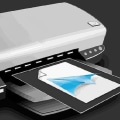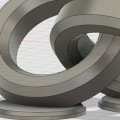3D printing has become increasingly popular in recent years, and the technology behind it is constantly evolving. Fused Filament Fabrication (FFF) printers are one of the most common types of 3D printers used today. FFF printers use a process of heating and extruding plastic filament to create three-dimensional objects. FFF technology is particularly useful for its versatility and affordability, making it a great choice for hobbyists, professionals, and anyone looking to get started with 3D printing. In this article, we will explore Fused Filament Fabrication (FFF) printers in greater detail, discussing their features, advantages, and limitations. The first step in understanding Fused Filament Fabrication (FFF) printing is to understand what it is.
FFF printing, also known as Fused Filament Fabrication, is a type of 3D printing that uses a heated nozzle to melt a filament of plastic or other material and then lay it down in layers to form a 3D object. The melted filament is then cooled and hardened, allowing it to take shape. FFF printing has several advantages over other forms of 3D printing, including cost, speed, and precision.One of the main advantages of FFF printing is its cost. FFF printers are relatively inexpensive compared to other 3D printing technologies, making them an attractive option for those looking to get into 3D printing without breaking the bank.
Additionally, FFF printing is fast, allowing for quick turnaround times on projects. Finally, FFF printing is also very precise, allowing for complex designs with intricate details to be printed with ease. In terms of materials, FFF printing can use a variety of plastics, including ABS and PLA, as well as nylon and other materials. The type of material used will depend on the application for which it is being used. For example, ABS is a good choice for projects that require strength and durability, while PLA is better suited for projects that need to be lightweight and flexible.
Additionally, there are specialty filaments available for more specific applications. The applications for which FFF printing is best suited include prototyping, small-scale manufacturing, and custom parts production. Because of its affordability and precision, it can be used to quickly produce prototypes or small batches of parts with minimal cost or effort. Additionally, because of its flexibility in terms of materials and its ability to create complex designs, it can be used to create custom parts for a variety of applications. Finally, it's important to note that FFF printing requires some degree of skill in order to produce quality results. This includes knowledge of the software used for creating 3D models as well as an understanding of the material being used and how it behaves when melted and cooled down.
Additionally, proper calibration of the printer is necessary in order to ensure accurate results.
Applications for FFF Printing
Fused Filament Fabrication (FFF) printing can be used for a variety of applications, from prototyping to custom parts production. It is particularly well-suited for small-scale manufacturing and other projects that require the production of a relatively low number of parts. FFF printing is often used for prototyping due to its affordability and versatility. With FFF printing, users can quickly and easily create prototypes of complex shapes that would be difficult to produce using traditional manufacturing methods.The ability to quickly iterate on designs can help reduce development time, allowing companies to bring products to market faster. FFF printing is also used for small-scale manufacturing, such as producing parts in low quantities or customizing products with personalized features. This makes it ideal for companies that need to produce products in small batches or that require customization. Finally, FFF printing is often used to produce custom parts, such as replacement parts for existing products or parts that are designed for specific applications.
This makes it an ideal solution for companies that need to produce one-off parts or that need to produce parts with unique features.
Advantages of FFF Printing
Fused Filament Fabrication (FFF) printing offers many advantages that make it an attractive choice for a variety of applications. One of the main advantages of FFF printing is its cost. FFF printers are generally much more affordable than other types of 3D printing, making them an attractive option for those on a budget.Additionally, FFF printing is usually faster than other 3D printing technologies, so it can be used to produce parts in a shorter amount of time. In addition to its affordability and speed, FFF printing offers very high precision. FFF printing can produce parts with accuracy levels that are comparable to those of other technologies, making it ideal for producing highly precise parts. Another advantage of FFF printing is its versatility.
FFF printers can be used to print a wide variety of materials, from plastics and metals to composites and even food. This means that FFF printing can be used for a wide range of applications, from prototyping to production. Finally, FFF printing is relatively easy to use. Unlike some other 3D printing technologies, FFF printing does not require extensive training or knowledge in order to use it effectively.
This makes it a great option for those who are new to 3D printing.
Skills Needed for FFF Printing
In order to successfully operate a Fused Filament Fabrication (FFF) printer, certain skills are needed. FFF printing requires knowledge of 3D modeling software in order to create the 3D models that will be printed. Additionally, the printer must be calibrated properly to ensure that the print job is successful. 3D modeling software is used to create the 3D model that will be printed.This software can be used to create complex shapes and objects with precise measurements. The 3D model then needs to be exported in a format that is compatible with the printer. Common file formats for FFF printing include .STL and .OBJ. Once the 3D model is ready to print, the printer must be calibrated. Calibration ensures that the printer’s nozzle is at the correct height and that there are no obstructions in the path of the filament.
It also helps to ensure that the filament is heated to the correct temperature for optimal printing results. Calibration should be done regularly in order to maintain optimal performance. In addition to knowledge of 3D modeling software and calibration of the printer, there are other skills that can be beneficial when working with FFF printers. These include troubleshooting issues that arise during printing, understanding various types of materials used in FFF printing, and choosing an appropriate print speed for a given material and model.
Materials Used in FFF Printing
Fused Filament Fabrication (FFF) printing offers a range of materials that can be used for various applications.The most common materials used in FFF printing are ABS and PLA plastics, as they are easy to work with and provide good results. ABS is an oil-based thermoplastic that is strong, impact-resistant and heat-resistant, making it a great choice for parts that need to withstand a lot of wear and tear. PLA is a biodegradable plastic derived from cornstarch or sugarcane, which is popular due to its low cost and ease of use. Both materials can be used in FFF printing, although PLA is typically preferred for its lower cost and easier printing process. Other materials that can be used in FFF printing include nylon, wood-filled PLA, carbon fiber reinforced PLA, and metal-filled PLA.
Nylon is a durable plastic that has excellent strength, flexibility and heat resistance, making it ideal for parts that need to be very strong and flexible. Wood-filled PLA is a combination of PLA and wood particles, giving it the look and feel of real wood. Carbon fiber reinforced PLA adds strength and rigidity to printed parts, while metal-filled PLA can be used to create parts with the look and feel of metal. No matter what material is used for FFF printing, it's important to choose the right one for the application. Different materials have different properties, so it's important to select the one that is best suited to the project at hand.
For example, ABS may be a better choice for parts that need to withstand wear and tear, while PLA may be more suitable for projects that require intricate detail. In conclusion, Fused Filament Fabrication (FFF) printing is a versatile and affordable type of 3D printing that has many advantages over other types of 3D printing technologies. It can produce high-quality parts quickly, with minimal cost and effort. Additionally, its flexibility with materials, along with its ability to create complex designs, make it suitable for a wide range of applications. However, calibrating the printer and having an understanding of 3D modeling software are necessary in order to achieve successful results. FFF printing is a great option for those who need to quickly produce prototypes or small batches of parts, as well as for those who are looking for a more custom solution.
It is important to consider the advantages and disadvantages of FFF printing before investing in the technology, in order to make sure it is the right fit for your needs.











Leave Message